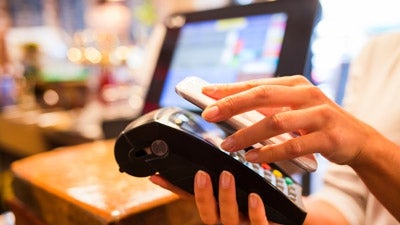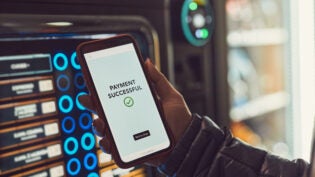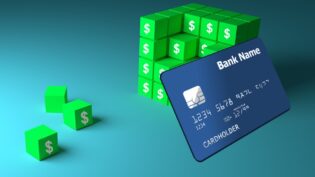
Disappointed at first in my inability to write about Google Wallet even though I’ve always been fascinated by NFC technology, in a moment of Zen-like clarity it occurred to me that my Google Wallet ennui might be tapping into a broader zeitgeist felt by mobile consumers and retailers with respect to NFC – “it sounds great, but…”
Mobile Payments: The Future of Retail?
In truth, I’ve been tracking NFC and mobile payments for years now, and I am convinced both will have a significant impact on the future of retail. In fact, the whole lot of us smartphone-toting consumers really should be using contactless mobile payment technologies like NFC – they’re demonstrably safer and arguably more convenient. But we haven’t and we don’t. Why is that?
Setting aside some of the more prosaic challenges to NFC payment adoption for the moment (don’t worry, I’ll come back to these soon enough), thus far the whole contactless payments concept has lacked a juicy storyline, a compelling narrative we can all get behind spearheaded by a champion we can all follow. Sure, the technology’s been there for some time, but the hook, the je ne sais quoi…it just hasn’t been there.
But now Apple’s in the game and everything has changed. The die is cast; feel free to hurry out to buy an iPhone 6 and start tapping at the register, because NFC mobile payments are here to stay.
You may be casting a dubious eye at my confidence bordering on arrogance. How can I be so sure Apple will be able to solve marketing technology’s version of the Gordian Knot and revolutionize the way we buy things when so many others have failed? With no disrespect to previous NFC also-rans – tech luminaries the likes of Page and Dorsey to name but a few – Apple has one thing that the others simply didn’t and don’t: the Apple Multigenerational Marketing Machine.
More on that later.
First, to properly set the stage (and heighten the drama), here’s a brief overview of some key challenges that bedeviled Apple rival Google as an early entrant into the NFC payments space.
A Case Study in Failure: Google Wallet
In May of 2011, Google sought to simplify how we pay for things both online and at the point of sale by introducing Google Wallet, a mobile app leveraging near-field communication (NFC) short-range wireless technology to enable consumers to pay for things at the point of sale with the mere wave (or tap) of their smartphone. At the time, Google Wallet promised to usher in an age of contactless payments. In a broader sense, Google sought to remove the need for a physical wallet altogether by allowing consumers to store credit cards, bank account information, gift cards, coupons, customer loyalty cards etc. on their smartphone or on the cloud. Fast forward three years later, though, and most of us are still fumbling for our physical wallet at the checkout counter. So what happened?
The Problem: Devices, Merchants, and Carriers
Despite the theoretical allure of contactless payment technologies such as NFC, the real-world adoption by consumers of NFC solutions like Google Wallet has been bedeviled by three factors: slow smartphone integration, spotty merchant participation, and resounding mobile carrier indignation.
Spotty Adoption by Devices and Merchants
As a general proposition, contactless payments require a two-way buy in: you need the participation of the smartphone producers on one hand and bricks-and-mortar merchants on the other (NFC-enabled smartphones used at NFC-enabled card readers at the POS).
On the smartphone side, recent data from research firm IHS shows NFC-enabled smartphone shipments rose dramatically in the past year, from 120 million in 2012 to 275 million in 2013; IHS predicts this upward trajectory to continue in the coming years, to over 1.2 billion units shipped by 2018.
When reflecting on these numbers, it’s important to note that the burgeoning NFC market is clearly dominated by Google’s Android mobile operating system – in 2013, shipments of Android smartphones topped 254 million units, or 93% of ALL NFC-equipped phones. A conspicuous holdout in the NFC landscape, it’ll be interesting to see how much market share Apple’s iPhone 6 can steal away from Android.
On the merchant side, acceptance of NFC has been slower going. According to RSR Research’s 2013 Payments Benchmark Study, only 18% of merchants are piloting mobile payments (although 17% have budgeted for it and 30% have plans to do so). In other words, NFC-enabled contactless payments are still in the early adaptor phase with merchants. Again, it is unclear to what extent Apple’s entry into the contactless payments space will encourage merchant involvement.
Outright Obstruction from Carriers
To further complicate things, even if your smartphone has NFC technology embedded within, you might not be able to use it. This is because your cellular carrier also must enable your device to use NFC with a digital wallet, and most major carriers have not been playing well with Google. The three mobile carriers that, taken together, control 81% of US wireless subscriptions – Verizon (35%), AT&T (32%), and T-Mobile (14%) – are actively blocking Wallet’s NFC payment capabilities. This means that none of the millions of AT&T, Verizon, or T-Mobile subscribers have been able to use Wallet’s NFC payments feature.
In the US, only Sprint, Virgin Mobile, US Cellular, and Metro PCS offer devices and service that work with Google Wallet and NFC. These carriers offer popular devices from the likes of Samsung, LG and HTC, along with Google Nexus 7 and Google Nexus 10 tablets, but only enjoy peripheral subscriber market share.
In November of 2013, the big three mobile carriers took their opposition to Wallet a step further by joining forces to launch the ISIS mobile wallet. Though viewed by many as a bit of a flop, the CEO of ISIS recently went on record stating the venture is now activating 20,000 new users per day. Whether or not this is true, the very fact he is touting these numbers suggests ISIS isn’t going away anytime soon.
To maintain the viability of Wallet, then, Google had to figure out a way to either side-step the major carriers or wholly reposition the service offering. Google being Google, they did both.
The Solution: Sidestep the Carriers Altogether
In the face of intransigence from the major mobile carriers, in November of 2013 Google rolled out the latest version of its Android Mobile operating system, known as KitKat (continuing the tradition of ascribing Android operating systems with confectionary-themed code names). About the same time, Google announced that Android 4.4 would support Host Card Emulation (HCE), a technology that enables NFC applications running on the KitKat OS to emulate smart cards and financial institutions and securely host payment accounts in the cloud. Without HCE, NFC-based cards need to be stored in a secure element that is embedded in mobile phone SIM cards controlled by mobile carriers. HCE allows payment information to be validated and stored remotely on the cloud, effectively bypassing the mobile device’s secure element.
HCE freed Google Wallet from the tether of the mobile device on which it runs and, by extension, the mobile telcomm carriers running it. Recognizing the opportunity, MasterCard quickly jumped on the opportunity to integrate MasterCard with Wallet through its PayPass service.
Given the big mobile carriers’ investment in ISIS, there was speculation that AT&T, Verizon and T-Mobile might try and hinder Wallet by hiding, disabling, or otherwise removing KitKat’s Tap and Pay feature. However KitKit updates have rolled out to all the major US carriers, and the Tap and Pay functionality seems to be alive and well.
In sum, Google Wallet is ready for business. The trick is getting people (merchants and customers) to use it.
Unlike Google, who uses the open HCE technology in its Wallet app, Apple has chosen to create its own secure element within the iPhone 6 in an effort to control the entire payment process within its device. Apple is betting that this nod to privacy will appeal to its 800-odd million iCloud users, many of whom already have their credit card information stored on the Apple cloud.
The Apple Pay page underscores the company’s firm commitment to data privacy:
With Apple Pay, instead of using your actual credit and debit card numbers when you add your card, a unique Device Account Number is assigned, encrypted and securely stored in the Secure Element, a dedicated chip in iPhone…With Apple Pay, your payments are private. Apple doesn’t store the details of your transactions so they can’t be tied back to you. Your most recent purchases are kept in Passbook for your convenience, but that’s as far as it goes.
Enter The Apple Multigenerational Marketing Machine
Taking a spin through the roster of partnerships announced in the US alone, it’s clear Apple is going all in on Apple Pay. Where Google struggled to ink deals with major banks and card carriers, Apple has secured agreements with the big three credit cards (American Express, MasterCard, and Visa), along with banks representing 83% of all credit card payments by volume. McDonald’s, Whole Foods Market, and Disney’s theme parks will feature Apple Pay compatible tills. You get the picture.
As a relatively late comer into the NFC contactless payments game, the fact that the company is able to post such a muscular ante speaks to the sheer breadth and power of the Multigenerational Marketing Machine Apple has assembled over the years.
Apple founder Steve Jobs is lauded as a visionary tech genius, a man with a clear vision who had a knack for coming up with paradigm-changing ideas in computing and design. To me, though, Jobs was a marketing genius first and foremost. As someone who cut his teeth in sales and marketing, I can’t honestly speak for Jobs’ tech chops, but I can and do marvel at his unparalleled ability to create a series of must-have products that appeal to so many different audiences, as well as his uncanny knack for infusing such inherent value in his offerings that price is often not even a consideration, even for the price conscious. These accomplishments transcend mere marketing strategies, campaigns, or initiatives – Jobs’ real genius lay in his ability to create a sustained movement around a brand, and by doing so to foster long-term, sustainable value, i.e. a bona fide Multigenerational Marketing Machine.
Here, There, Everywhere
I can find ample evidence of the Apple Multigenerational Marketing Machine at work in my own backyard, where I am surrounded by no fewer than four generations (Gen Zers, Millennials, Gen Xers, and Boomers) of Apple-toting converts close at hand.
- Gen Z – My 8-year-old son, who is convinced his iPod has semi-mystic technological capabilities that far surpass Android. He’s also an avid collector of iPod cases (should’ve gotten into that business).
- Millennials – My co-workers, all anxiously huddled around their Apple devices on the day Tim Cook announced Apple’s foray into mobile payments; it was as if they were listening to the moon landing or the outbreak of war. When I questioned how they could possibly care so much about a new device rollout, I was laughed out of the room – literally.
- Gen Xers – At a recent family barbeque, I made the mistake of suggesting that Apple products are overpriced and not really technologically superior to Android/HP/Microsoft/etc. This seemingly benign statement almost brought my sister-in-law to tears. Wow.
- Boomers – My father-in-law’s support of Apple was perhaps the most shocking experience of them all. A retired insurance actuary who wears his prudent frugality as a badge of honor – he can’t bring himself to pay two dollars for a soda at a restaurant knowing it only costs the house two cents – I never pegged him for an Apple man. In the end, though, even he bowed to the overwhelming pressure of the Apple Multigenerational Marketing Machine and went with an iPhone 5 over a Galaxy S4, and then made matters worse by opting for a Macbook over an HP. I couldn’t believe it.
The Market Opportunity of Apple Pay
According to mobile research firm IDC, Android devices are projected to control a whopping 80.2% market share of the global smartphone market in 2014, compared to just 14.8% for iOS (Apple). iPhone market share in the US fares much better by comparison, with Q2 2014 number hovering just north of 40%. While overall smartphone adoption numbers will always be a relevant statistical metric, when it comes to the mobile payments game, affluence – and its direct correlation to higher levels of disposal income – is the key factor. Here Apple dominates, with the iPhone clearly the smartphone of choice among the rich and well heeled, at least in the US. If you don’t believe me, I encourage you to check out this fascinating post.
While global demand for mobile contactless payments is, admittedly, still in its infancy, the numbers are heading the right direction. Research firm Gartner predicts the mobile payment transactions market will reach $507 billion in this year, although almost all of this revenue will be derived from SMS text payment solutions. Gartner also forecasts that the value of NFC-generated mobile payments will rise sharply from the $5 billion realized in 2013 to almost $22 billion by 2016.
Needless to say, Apple is well positioned to make the most of the global transition to mobile payments:
- More than 800m iCloud accounts are in use; almost all have a credit card attached for payments for apps, movies and TV shows. As of June 2014, 75 billion apps have been downloaded from the Apple App Store.
- iPhone sales were responsible for over half (52.11%) of Apple’s 37.4 billion global revenue and 7.7 billion net profit for Q3 2014.
- In April of 2014, Forbes published a somewhat shocking article noting how Apple had $160 billion (with a B) in cash reserves, which at the time amounted to roughly 3X that of the US Treasury ($49B).
It seems as though Apple CEO Tim Cook shares this sentiment. “We’re gonna start by focusing on payments. Payments is a huge business. Every day between credit and debit we spend 12 billion dollars. That’s over 4 trillion dollars a year, and that’s just in the United States…200 million transactions a day. That’s 200 million times we scramble for our credit cards and go through what is a fairly antiquated process.”
His words echoing the actions of the company he leads, it sounds to me like Tim Cook and Apple are all in on mobile payments. Cry “Havoc!” And let slip the Apple Multigenerational Marketing Machine…
This article was originally published by SyneCore
2826 Views












